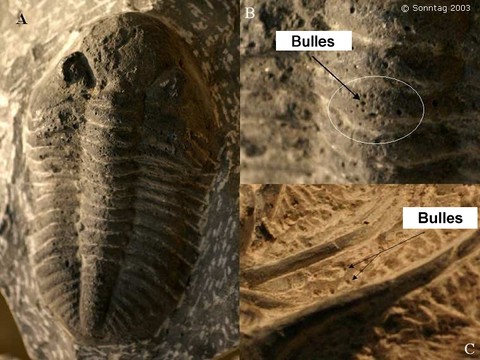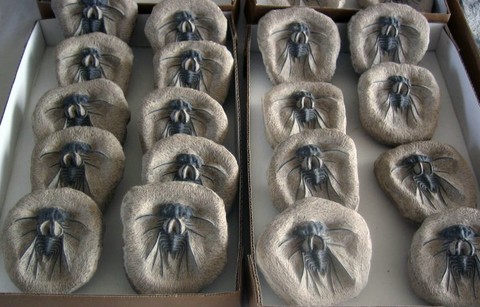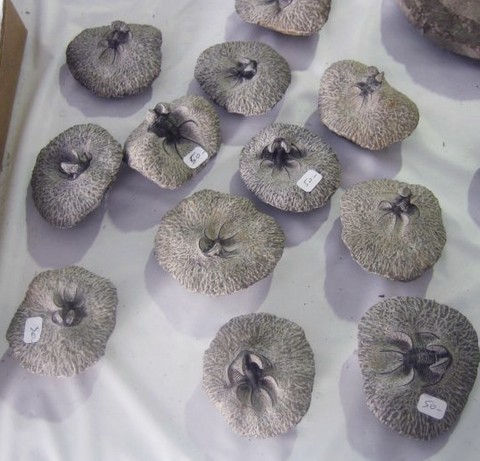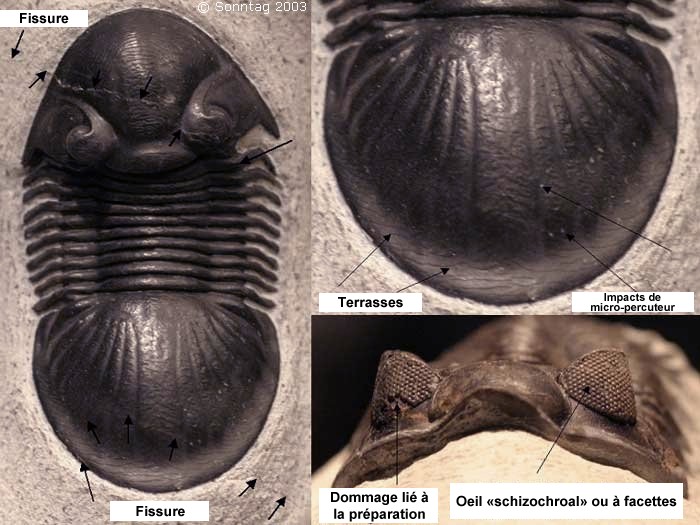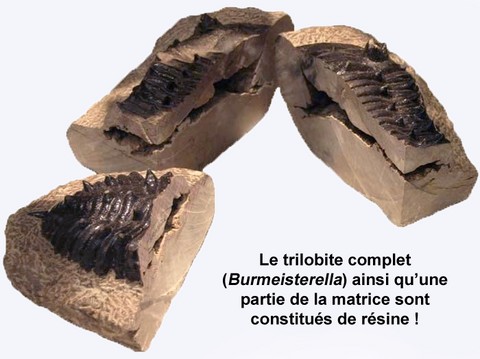 How to identify trilobites fakes
How to identify trilobites fakes
As mineral trader, we have the opportunity to visit numerous exhibitions and thus have been able to observe and study numerous falsified trilobites. This knowledge and experience were acquired after years of effort and today allow us to quickly identify fake trilobites, something sometimes difficult for neophytes who are unfortunately incapable of spotting signs of fakery... It is regrettable that Today in 2013 the market is flooded with counterfeits which bring discredit to our profession : the trading of geological samples! This is why it is our duty to share our knowledge in recognizing false trilobites with you !
A little bit of history :
Trilobite trafficking is not new... Fossil falsification, assemblages and restoration are as old as the fossil trade itself. The problem is that the deception is profitable, moreover, as is often the case in countries of the South, it is catalyzed by poverty and precariousness.
In the 19th century, Barrande employed what he called "stone men" to search for areas near Prague rich in trilobites. Special finds were rewarded with a higher reward, leading some "stone men" to deceive their employers by producing fake trilobites in order to earn a larger reward. Many of these tricked trilobites have even found their way into the collections of major European museums, where they are presented today as curiosities (Budik and Turek, 2003).
A simple way to create a fake trilobite was to assemble disparate parts, sometimes resulting not only from different specimens, but even from different genera. Some of these so-called "rare" specimens have been sold to museums and educational institutions. For example, there was a trilobite assembled from the cephalon of a Phacops, the pygidium of an Odontochile and with a thorax comprising only 4 segments (Šnajdr, 1992). However, at that time, the various parts of the faked trilobites were at least authentic. Nowadays, while assemblages persist, new falsification techniques have developed, notably involving the use of synthetic resins which allow the molding of part or all of the specimens...
The trilobite cottage industry has evolved in the wake of sensational discoveries in the Moroccan desert near Alnif, Erfoud and Tabourikt over the past 30 years. This took place in a region where running water, electricity and education were mostly unavailable. Moroccans and nomads discovered that the collection and preparation of trilobites or more generally fossils was a viable source of income, this became for some the only means of subsistence. Over the years, this cottage industry has evolved to become a vital part of the economy, particularly in areas of extreme poverty in the High Atlas Mountains where many trilobites are found.
Burkhard and Bode (2003) note that there are well-known manufacturers in Morocco who produce fake trilobites. Fossil sellers who buy locally know these workshops. Manufacturers do not hide their production methods, they present their products as replicas. It is therefore easy to assume that some fossil traders and exporters who go to Morocco to buy trilobites are well aware that those from these sources are not real...Thus, fraud occurs when dealers knowingly buy these replicas at low prices to redistribute them on the market at favorable rates... The manufacture of fake trilobites appears to have started in the 1980s, and was particularly evident for the highly sought after Paradoxides when sources were exhausted. Initially several different parts of Paradoxides were combined which then led to the falsification of most trilobites. Apparently, the idea of forgery is not attributable to Moroccans, but to American and European dealers who encouraged the imposture with financial incentives. Resellers then sold the fakes as authentic. This process has unfortunately escalated to encompass most trilobite species in Morocco. The phenomenon has become so widespread that today there may be more counterfeits on the market.
A quick reminder of the nomenclature of trilobites :
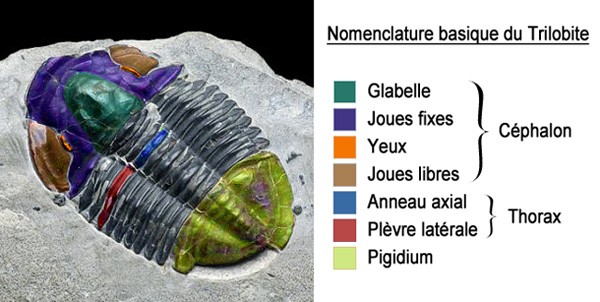
Asaphiscus wheeleri meek true from the Middle Cambrian, House Range Mountains, Millard Co., Utah, U.S.A. - 5.2 cm in length
You should know that like the vast majority of arthropods, trilobites molt. They therefore changed their shell regularly as they grew. Trilobites can sometimes be found with missing “free cheeks”. These removable parts of the cephalon (head) allowed the animal to emerge from its old shell. Most of these animals are said to be benthic; that is, they moved on the seabed. We are attaching a small diagram to illustrate from the site www.trilobites.info.

Clues to identify fake Moroccan trilobites :
a. - Air bubbles in the matrix and the exoskeleton
The presence of bubbles or small, more or less spherical holes is an important indicator that the trilobite is a fake. These holes, normally less than 0.5mm in diameter, are artifacts of the bubbles that form during the curing of the cast resin. These bubbles are apparently inevitable in the harsh environment of the Moroccan desert.
The photo montage shows a Phacops entirely cast in resin and then reassembled on a natural limestone matrix. A.- The tiny holes on the surface of the exoskeleton are easily visible, these are the famous bubbles inherent to the resin: a unique signature of the imposture. B.- Close-up of the pleural spines show telltale holes, more bubbles... C.- This close-up of a tricked Dicanurus shows the presence of bubble in the matrix (also note that the limestone should be gray and not an unnatural pale brown).
b. - Color differences in the matrix of castings
Especially with Moroccan Devonian trilobites, when the matrix adjacent to the trilobite is light brown while the underside of the matrix is a dark gray, the trilobite is a cast. The natural matrices are uniform dark gray in Hamar L'Aghdad and reddish or pale yellow in Laatchana. The color differences as well as the numerous preparation marks on the surface (in order to hide the tiny bubbles) indicate that the trilobite and a thin thickness of adjacent matrix were cast together and then reassembled on a possibly natural limestone. Particularly in Cambrian trilobites, variations in matrix color may indicate an assembly from fragments of different specimens. Close inspection usually reveals the fine lines that separate parts of different colors stuck together. Authentic trilobites should have large areas of consistent color, although the broken matrix may have been glued back together.
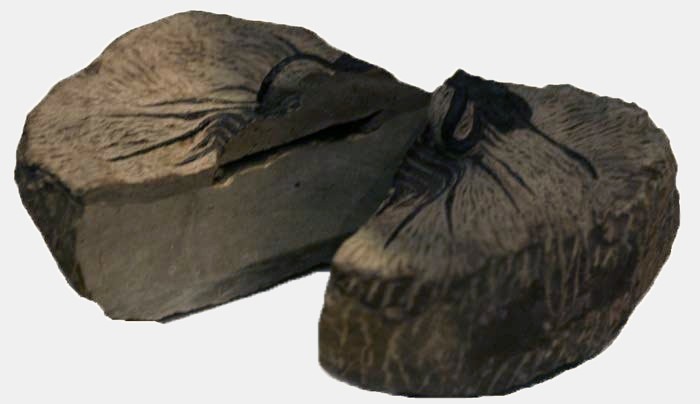
In the photo above it is a false Dicranusus monstrosus. The trilobite and adjacent matrix were cast in a pale brown resin and then mounted on a real piece of limestone. The faux trilobite was then painted, and the surrounding matrix worked to replicate the preparation marks. Sawing a forgery provided definitive proof by revealing a large void beneath the trilobite, as well as color differences between the light brown upper resin layer and the actual gray limestone beneath. The photo was taken by Sonntag and the sawn trilobite by Horst Burkhard. The photos below show series of Dicanurus on the left at a show sold for €50 each, their resemblance already arouses suspicion... On the right, fake Ceratarges...
c.- Cracks in Devonian trilobites as a potential indicator of authenticity
Unlike the trilobites found in schists which have undergone deformation, the Devonian trilobites come from a very hard limestone, difficult to extract. Therefore, Moroccan trilobites normally exhibit fine intersecting lines which are cracks or fractures. They normally intersect both the remains of the animal and the womb. In fact, before their preparation several pieces can be glued back together. The absence of these cracks may constitute an indication of counterfeiting, however these fractures may also be absent due to very precise preparation techniques.
d.- The characteristics of the trilobite exoskeleton as an indicator of imposture
Moroccan trilobites from the Devonian exhibit a black exoskeleton, although different brown and greenish hues are also seen, they are much rarer. False trilobites are found in slightly different colors, often brownish, and appear unusually shiny most of the time. However, micro-sanding during preparation can also generate a shiny surface. Biting trilobites with your incisors can be a good test of authenticity. False trilobites give a "soft" feeling to the bite, as one would feel when biting plastic. This simple and safe test uses the sensitive nerves in your teeth, and cannot harm a real trilobite which is significantly harder than its resin knockoffs. Only light pressure is needed, don't try to bite into it for obvious reasons...
Please note, Moroccan trilobites from the Ordovician and Cambrian present different colors from those from the Devonian. Fossils normally contain hydrated iron oxides which are responsible for the ochre, brown or orange colors, rather than yellow or black.
Knowing a few characteristics of authentic trilobites can help differentiate a fake from a real one (see montage below). The Paralejurus in the photo on the left is authentic, it has characteristic crack lines indicated by arrows. The upper fissure is remarkable, it intersects the cephalon and the matrix, the fissure on the pygidium is less obvious. On the enlargement of the pygidium of Paralejurus at the top right we note small lines of terraces. These lines are normally absent on fake trilobites or whose preparation with the micro-sandblaster has been too aggressive. We also notice small white spots which appear occasionally everywhere, they correspond to the places where the micro-percussor has touched the exoskeleton, careful preparation makes it possible to limit these minor defects. The last photo at the bottom right shows the eyeballs of a trilobite from the order Phacopida. The facets are a sign of authenticity because they are very difficult to counterfeit. It should be noted, however, that "schizochroal" eyes are unique to the suborder Phacopina, abundant in the Moroccan Devonian. Many other orders of trilobites are abundant but do not have schizochroal eyes (e.g. Lichida, Harpetida, Proetida).
e.- Morphological characteristics, surface details and eyes of trilobites as clues
The exoskeletons of real trilobites usually show structural details, imperfections and ornamentation, but also varied spines, tubercles, ridges and hollows. Look closely at the eyes of trilobites, Phacopina have schizochroal lensed eyes visible to the naked eye. Fake trilobites generally do not have these characteristic details which are very difficult to copy. False Phacopina usually have smooth eyes rather than schizochroal eye surfaces, as the required casting techniques are difficult to achieve and are therefore not yet used in Morocco.
f.- UV lamps and solvents as tools to identify resins
Black light emitted by a UV lamp can reveal counterfeits because the resins reflect UV light differently than the limestone matrix. A real trilobite is made of the same rock as its matrix, however the resins tend to shine but also fluoresce creating a contrast on tampered specimens. Be careful though, certain preparation techniques can increase the reflectivity of authentic trilobites.
Moroccan trilobites, both fake and genuine, have sometimes been coated with an unidentified, black chemical. Applying a solvent such as acetone or Bindulin can remove these patinas. By passing the solvent with a brush the paste comes off in a few seconds, as do other artificial colors. The reconstructed areas will appear whitish.
g.- The ultimate but destructive determination...
If after all the previous tests and observations doubt remains, then destruction may be the only recourse... With a saw with a diamond blade, it is possible to cut the trilobite. In the photo you can note a void below the animal, this means that it was sealed on a piece of matrix... it is a cast and painted Burmeisterella... irrefutable proof... Photograph by Sonntag and specimen from the Burkhard collection.
Références :
- fossilmuseum.net
- BUDIL, P. & TUREK, V. (2003): Trilobitenland Tschechien. – Offizieller Katalog der 40. Mineralientage München, Turmalin und Trilobit: 94-99, 8 unn. Abb. München
- BURKHARD, H. & BODE, R. (2003): Trilobitenland Marokko. Keine Angst vor Fälschungen. – Offizieller Katalog der 40. Mineralientage München, Turmalin und Trilobit: 136-144, 22 unn. Abb., München.
- ŠNAJDR, M. (1990) : Bohemian Trilobites. – 265 S. Prag

